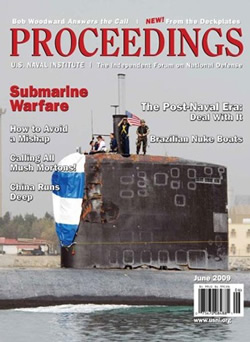 |
|
An article in USNI, which carries this photo of USS Hartford (SSN-768) damaged in a recent collision, discusses China’s ballistic missile submarines. |
By Hans M. Kristensen
The magazine U.S. Naval Institute Proceedings has an interesting article about China’s nuclear ballistic missile submarines written by Andrew S. Erickson and Michael Chase from the U.S. Naval War College. And I’m not just saying that because they reference several of my publications about China, but because they provide an interesting discussion of the possible motivations for China’s emerging sea-based nuclear force.
I, for one, have always wondered why, if China’s current strategic modernization is intended to reduce the vulnerability of its long-range nuclear deterrent, would China want to cluster a significant portion of its missiles on a few submarines and send then out to sea where U.S. attack submarines can hunt them down?
In theory a sea-based nuclear deterrent is invulnerable because it can hide. But given that the U.S. Navy’s Maritime Strategy in the 1980s was explicitly designed to find and sink Soviet ballistic missile submarines before they could launch their missiles, how secure will China’s sea-based nuclear deterrent actually be? Or how would China react in a crisis, if one of the submarines went missing due to an accident?
.
Satellite imagery has long served as a tool for observing on-the-ground activity worldwide, and offers especially valuable insights into the operation, development, and physical features related to nuclear technology.
This report outlines a framework relying on “Cooperative Technical Means” for effective arms control verification based on remote sensing, avoiding on-site inspections but maintaining a level of transparency that allows for immediate detection of changes in nuclear posture or a significant build-up above agreed limits.
The grant comes from the Carnegie Corporation of New York (CCNY) to investigate, alongside The British American Security Information Council (BASIC), the associated impact on nuclear stability.
Satellite imagery of RAF Lakenheath reveals new construction of a security perimeter around ten protective aircraft shelters in the designated nuclear area, the latest measure in a series of upgrades as the base prepares for the ability to store U.S. nuclear weapons.